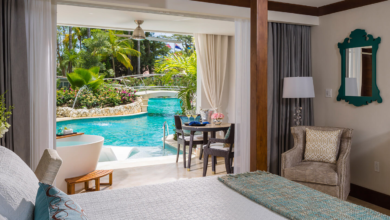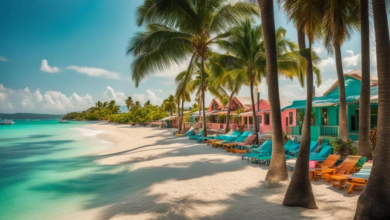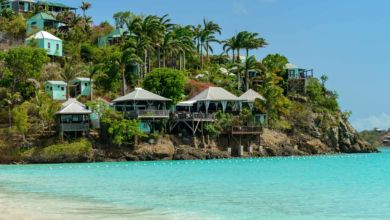Exploring the Marvels of Brazil: A Traveler’s Guide to Unforgettable Adventures

Introduction:
Travel and tourism in Brazil offer a world of wonders, captivating visitors with its rich cultural heritage, breathtaking natural landscapes, and vibrant cities. From the iconic landmarks of Rio de Janeiro to the lush Amazon rainforest, Brazil offers an array of experiences that cater to every traveler’s interests. In this guide, we will embark on a virtual journey across this diverse country, exploring the major cities and providing insights into the best ways to navigate between them.
I. Rio de Janeiro: The Marvelous City
Rio de Janeiro, with its stunning beaches, vibrant samba rhythms, and iconic landmarks, is an essential stop on any Brazilian adventure. Begin your journey with a visit to the magnificent Christ the Redeemer statue, perched atop Corcovado Mountain, offering panoramic views of the city. Immerse yourself in the electric atmosphere of Copacabana and Ipanema beaches, where you can soak up the sun, enjoy thrilling water sports, or sip refreshing caipirinhas. Don’t forget to explore the bohemian neighborhood of Santa Teresa, with its charming cobblestone streets and vibrant art scene.
II. São Paulo: The Urban Jungle
As Brazil’s largest city, São Paulo is a bustling metropolis that pulsates with energy and diversity. Dive into the city’s vibrant cultural scene by visiting world-class museums like the São Paulo Museum of Art and the Pinacoteca do Estado. Indulge in a gastronomic adventure, exploring the city’s diverse culinary offerings, from traditional feijão com arroz to contemporary fusion cuisine. For a relaxing escape, explore Ibirapuera Park, a sprawling green oasis where you can enjoy picnics, rent a bike, or simply unwind amidst nature.
III. Salvador: The Afro-Brazilian Gem
Salvador, the capital of Bahia, is a city steeped in history, known for its vibrant Afro-Brazilian culture. Lose yourself in the colorful streets of Pelourinho, a UNESCO World Heritage site, with its colonial architecture, lively squares, and rhythmic sounds of capoeira. Immerse yourself in the rich cultural heritage through vibrant festivals, such as Carnival and Lavagem do Bonfim. Taste the flavors of Bahian cuisine, savoring mouthwatering acarajé and moqueca while enjoying the rhythmic beats of traditional music.
IV. Manaus: Gateway to the Amazon
For an extraordinary encounter with nature, venture into the heart of the Amazon rainforest from the city of Manaus. Explore the lush greenery, spot exotic wildlife, and experience the serene beauty of the mighty Amazon River. Embark on a boat expedition, hike through the dense jungle, and engage with indigenous communities to gain a deeper understanding of this unique ecosystem. Don’t miss the breathtaking Meeting of the Waters, where the Rio Negro and Solimões rivers merge but flow separately, creating a mesmerizing natural phenomenon.
V. Traveling Between Cities: Seamless Connections
To navigate between Brazil’s major cities, several transportation options are available. Domestic flights offer convenient and time-efficient travel, connecting major airports like Rio de Janeiro-Galeão International Airport (GIG), São Paulo-Guarulhos International Airport (GRU), and Salvador International Airport (SSA). Brazil’s bus network, operated by companies like Itapemirim and Viação Cometa, provides an affordable and scenic alternative, allowing you to witness the country’s landscapes up close. Additionally, Brazil’s well-developed railway system offers connections between cities, including the iconic São Paulo-Rio de Janeiro route.

additional details on transportation options between Brazil’s major cities, including typical travel times and costs:
- Domestic Flights:
Domestic flights are a popular choice for traveling between major cities in Brazil. The country has a well-connected network of airports, and several airlines operate frequent flights. Travel times and costs can vary depending on the distance between the cities and the airline you choose.
- Rio de Janeiro to São Paulo: The flight duration between Rio de Janeiro (GIG or SDU airports) and São Paulo (GRU or CGH airports) is approximately 1 to 1.5 hours. Prices can range from around $50 to $150 USD, depending on factors such as the airline, booking time, and availability.
- Rio de Janeiro to Salvador: Flying from Rio de Janeiro to Salvador takes around 2 to 3 hours. Prices typically range from $100 to $250 USD, depending on the airline and booking conditions.
- São Paulo to Salvador: The flight duration between São Paulo and Salvador is approximately 2 to 3 hours. Prices can vary from around $100 to $250 USD, depending on factors such as the airline, time of booking, and demand.
- Bus Services:
Brazil has an extensive bus network, offering an affordable and scenic way to travel between cities. Travel times and costs will depend on the distance and the class of service chosen (e.g., standard, semi-cama, or executivo).
- Rio de Janeiro to São Paulo: The bus journey between Rio de Janeiro and São Paulo takes around 5 to 7 hours, depending on the traffic and route. Prices for a one-way ticket can range from approximately $20 to $50 USD, depending on the bus company and the class of service.
- Rio de Janeiro to Salvador: Traveling by bus from Rio de Janeiro to Salvador is a long journey, typically taking around 24 to 30 hours, depending on the route and stops. Costs for a one-way ticket can range from approximately $70 to $150 USD, depending on the bus company and the class of service.
- São Paulo to Salvador: The bus journey between São Paulo and Salvador is also quite long, taking approximately 24 to 30 hours, depending on the route and stops. Prices for a one-way ticket can range from approximately $70 to $150 USD, depending on the bus company and the class of service.
- Train Services:
While train travel is not as prevalent in Brazil as other transportation options, there are some scenic routes available.
- São Paulo to Rio de Janeiro: The São Paulo-Rio de Janeiro train route, known as the “Trem de Prata” or Silver Train, offers a picturesque journey through the Atlantic Forest. However, please note that this train service may not operate regularly or may be subject to changes. It’s advisable to check the latest information and schedules if you are interested in this option.
It’s important to note that the mentioned travel times and costs are approximate and subject to change based on various factors such as season, demand, and promotions. It’s recommended to check with the specific airlines, bus companies, or train services for the most up-to-date information regarding schedules and prices.
comparison of costs and travel times between flights and buses for traveling between major cities in Brazil:
- Rio de Janeiro to São Paulo:
- Flights: The flight duration is approximately 1 to 1.5 hours, and prices can range from around $50 to $150 USD, depending on the airline and booking conditions.
- Buses: The bus journey takes around 5 to 7 hours, and prices for a one-way ticket can range from approximately $20 to $50 USD, depending on the bus company and the class of service.
- Rio de Janeiro to Salvador:
- Flights: The flight duration is approximately 2 to 3 hours, and prices typically range from $100 to $250 USD, depending on the airline and booking conditions.
- Buses: The bus journey is quite long, usually taking around 24 to 30 hours, and prices for a one-way ticket can range from approximately $70 to $150 USD, depending on the bus company and the class of service.
- São Paulo to Salvador:
- Flights: The flight duration is approximately 2 to 3 hours, and prices can vary from around $100 to $250 USD, depending on the airline and booking conditions.
- Buses: The bus journey is also quite long, usually taking around 24 to 30 hours, and prices for a one-way ticket can range from approximately $70 to $150 USD, depending on the bus company and the class of service.
In general, flights provide faster travel times compared to buses, especially for long distances. However, flights tend to be more expensive, particularly when booked closer to the travel date or during peak seasons. Buses, on the other hand, offer a more affordable option but require longer travel times.
When deciding between flights and buses, consider factors such as your budget, time constraints, personal preferences, and the availability of deals or promotions. Additionally, consider the comfort and amenities provided by the transportation mode, as flights generally offer more convenience and comfort compared to long bus journeys.
It’s important to note that the mentioned costs and travel times are approximate and can vary depending on various factors such as the airline, bus company, booking conditions, and travel season. It’s recommended to check with specific providers and compare prices to make an informed decision based on your preferences and travel needs.

Bus services in Brazil offer various classes with different amenities to cater to different traveler preferences. Here’s a breakdown of the commonly available bus service classes and the amenities they typically offer for longer journeys:
- Standard/Convencional:
The standard or convencional class is the most basic and economical option. It provides comfortable seating but fewer amenities compared to higher classes. The amenities typically include:
- Reclining seats: Standard buses usually have reclining seats to provide basic comfort during the journey.
- Air conditioning: Most buses are equipped with air conditioning to maintain a comfortable temperature.
- Restroom: Buses generally have onboard restrooms for convenience during long trips.
- Luggage storage: There are designated areas for storing luggage beneath the bus or in overhead compartments.
- Semi-Cama/Semi-Bed:
The semi-cama or semi-bed class offers a higher level of comfort and additional amenities compared to the standard class. The amenities typically include:
- Reclining seats: Semi-cama buses have seats that recline further than standard buses, allowing passengers to relax and rest more comfortably.
- Leg rests: Some semi-cama buses may have leg rests or footrests for added comfort.
- Blankets and pillows: Many semi-cama services provide blankets and pillows to enhance passenger comfort during the journey.
- Onboard entertainment: Some buses may offer individual entertainment screens or shared screens showing movies or TV shows.
- Snacks and beverages: Depending on the bus company, complimentary snacks and beverages may be provided.
- Executivo/Executive:
The executivo or executive class offers a higher level of comfort and additional amenities compared to the semi-cama class. The amenities typically include:
- Spacious seating: Executive buses often have more spacious and comfortable seats with additional legroom.
- Enhanced seat features: Seats may have more advanced features like increased recline, adjustable headrests, and armrests.
- Onboard services: Some executive services provide onboard attendants who offer personalized service, including serving meals and assisting passengers.
- Meals and beverages: Executive buses may offer complimentary meals, snacks, and beverages during the journey.
- Wi-Fi and power outlets: Many executive buses provide Wi-Fi connectivity and power outlets, allowing passengers to stay connected and charge their devices.
- Individual entertainment systems: Some executive services offer individual entertainment systems with personal screens and a selection of movies, TV shows, or music.
It’s important to note that the availability of amenities may vary depending on the bus company, route, and fare. Not all buses will have all the mentioned amenities, especially on shorter routes or lower-priced services.

cama, and executive classes, there are additional premium or luxury bus service options available in Brazil. These premium classes provide an elevated level of comfort, luxury amenities, and personalized services. While the availability of these classes may vary depending on the bus company and specific routes, here are some examples of premium or luxury bus service options:
- Leito/Lie-Flat:
The Leito or lie-flat class offers the highest level of luxury and comfort on long-distance bus journeys. These buses typically provide fully flat beds or large seats that recline to a near-horizontal position, allowing passengers to sleep comfortably during the trip. Additional amenities may include:
- Private cabins: Some Leito services offer private cabins with individual partitions for enhanced privacy.
- Premium bedding: Luxurious bedding, including high-quality pillows, blankets, and sheets, is provided for maximum comfort.
- Onboard entertainment: Individual entertainment systems with personal screens and a wide selection of movies, TV shows, or music.
- Gourmet meals: Premium meals are offered, often with a choice of menu options, served by onboard attendants.
- Exclusive lounges: Passengers may have access to exclusive lounges at bus terminals, providing a comfortable waiting area before departure.
- Double Decker:
Double-decker buses provide a unique and spacious travel experience, with the seating arrangement spread over two levels. These buses typically offer panoramic windows and additional amenities such as:
- Upper-level seating: Passengers can choose to sit on the upper deck, providing scenic views during the journey.
- Extended legroom: Double-decker buses often provide more legroom for added comfort.
- Onboard amenities: Depending on the bus company, amenities may include Wi-Fi, power outlets, individual screens, and onboard restrooms.
- VIP or Premium Services:
Some bus companies offer VIP or premium services that provide an enhanced travel experience. While the specific amenities and services can vary, they often include:
- Spacious and comfortable seating: VIP services feature larger seats with increased legroom and superior comfort.
- Dedicated attendants: Attendants provide personalized service, assisting passengers and attending to their needs.
- Gourmet meals and beverages: Passengers can enjoy high-quality meals, snacks, and a selection of beverages during the journey.
- Exclusive lounges and priority boarding: VIP passengers may have access to exclusive lounges at terminals and enjoy priority boarding.
- Premium onboard facilities: These may include individual entertainment systems, Wi-Fi, power outlets, and other luxury amenities.
It’s important to note that premium or luxury bus services are typically priced higher than standard or executive classes due to the elevated level of comfort and services provided.
Conclusion:
As you embark on your journey through Brazil, prepare to be enchanted by its vibrant cities, awe-inspiring landscapes, and warm hospitality. From the bustling streets of Rio de Janeiro to the cultural tapestry of Salvador and the untouched beauty of the Amazon rainforest, Brazil offers an unparalleled travel experience. Embrace the diverse cultures, savor the flavors of Brazilian cuisine, and immerse yourself in the rhythmic beats of samba. Whether you seek adventure, relaxation, or cultural exploration, Brazil will leave an indelible mark on your heart, creating memories that will last a lifetime.
When you click on the following link, you will find everything that helps in travel and tourism, latensa tells us in which country you are staying so that we can provide you with the service and you are your place waiting for your facility
https://trip.tp.st/dybR2RtH





Somebody essentially help to make significantly articles Id state This is the first time I frequented your web page and up to now I surprised with the research you made to make this actual post incredible Fantastic job